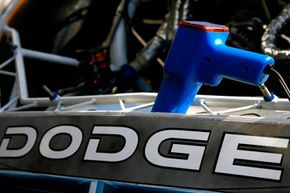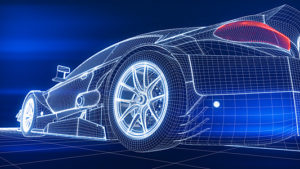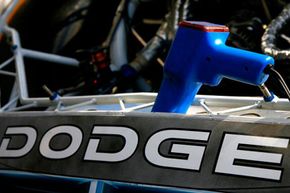\”

It doesn\’t exactly inspire confidence when you\’re driving along and feel a sudden succession of shudders and thumps emanating from your car engine. Knocking, as the condition is known, could be a sign of something dire…or it could just mean the engine\’s timing is a little off.
What do you do? Well, you could take your car down to Honest Al\’s Auto Repair and fork over the dollar-equivalent of a nice evening out for two…so Al could merely tell you what the problem is (actually fixing it is extra, of course). Or, if you have an older model car that uses a distributor, you could diagnose the problem on your own using a timing light.
Simply put, a timing light helps to fine tune when the spark fires from the spark plug and ignites your car\’s fuel. Properly adjusted timing, in turn, helps to make sure your engine works at peak power and efficiency. And who doesn\’t want that?
First, you should know that timing lights come in a few different shapes and sizes, and range in features from bare-bones functionality to lots of bells and whistles. The simplest and least expensive timing lights fit into a basic pen shape. But most people would probably prefer the much cooler, ray gun-shaped, "pistol grip" variety…because they\’re more ergonomic inside the close confines of a car\’s engine bay (yeah, that\’s it). More importantly, the more expensive the timing light is, the more likely it will be easier to read even in bright conditions.
(This information, by the way, applies to mostly older vehicles, which use a distributor to send electrical energy to the spark plugs. Newer cars with distributorless ignition systems use a computer to control the ignition process.)
One cool thing about timing lights is that unlike a flashlight, you never have to worry about running out of juice to power the light. That is, as long as your car runs and is connected to a working 12-volt battery. Getting your timing light ready for action is breathtakingly simple. With the engine off, you merely clamp the timing light\’s red wire to the battery\’s positive terminal, then the black wire to the battery\’s negative terminal. Lastly, you take the signal wire and clamp it directly to the Number 1 spark plug wire. (If you\’re not sure which is the "Number 1" spark plug wire, stop! And get thee to a service manual or online owners\’ forum for your vehicle.)
With a few of the timing lights out there, you might have to attach the unit\’s spark signal pick-up wire directly to the spark plug tip. Most light units on the market today, however, clip right to the spark plug wire itself. These inductive timing lights are able to detect the jolt of electricity each time the spark plug fires, similar to a doctor using a stethoscope to determine your body\’s pulse. When you pull the trigger of the timing light (with the engine running), each time the Number 1 plug fires, the timing light flashes a beam of light.
Through a phenomenon known as the stroboscopic effect, a properly aimed timing light will indicate where the Number 1 piston is in its up-and-down travel when the spark fires. Representatively speaking, that is. Obviously, you don\’t see the actual piston\’s location. Instead, the timing of the spark is measured in terms of degrees. The degrees refer to how far the crankshaft has rotated relative to the Number 1 cylinder\’s piston at top dead center (TDC) of the compression stroke.
On some vehicles, the crankshaft pulley has a bunch of degree marks and numbers on it. The engine has a mark right next to the pulley that represents TDC. The strobing timing light "freezes" the motion of the pulley and allows you to see how many degrees before or after TDC the spark is firing. By manipulating the distributor cap (turning it slightly clockwise or counterclockwise), you can adjust that timing of the spark delivery. To make things more confusing: Sometimes the timing marks are found on the flywheel or even on the fan pulley. And sometimes the indicators are reversed. So just read your vehicle\’s manual and know what you\’re looking for before you start waving that light gun around!
For any number of reasons, a person might wish the spark to fire earlier than the piston reaching TDC (this means the timing is advanced). Conversely, if excessive knocking is a problem, it might seem a better idea to have the spark ignite the fuel slightly after the piston reaches TDC (this means the timing is retarded).
How do you know what the proper timing specifications are? You can easily find that on your Vehicle Emission Control Information Label (located on the underside of the hood or along a fender well for vehicles built in the United States) or in a service manual specific to your vehicle.
These are generalized instructions for how timing and a timing light works. Depending on the quirks of your vehicle and which timing light you use, what you actually see under the hood may differ. You can use more advanced procedures (for instance, adjusting the vacuum timing) to wring even more finely tuned performance out of your vehicle. Regardless, the best thing to do is read the specific instructions in your vehicle\’s service manual, and the directions that came with the model of timing light you use. Also, remember that any aftermarket equipment you install, like non-standard spark plugs or spark plug wires, could result in inaccurate readings.
Originally Published: May 16, 2012
Timing Light FAQ
What does a timing light do?
Simply put, a timing light helps to fine tune when the spark fires from the spark plug and ignites your car\’s fuel. Properly adjusted timing, in turn, helps to make sure your engine works at peak power and efficiency.
How do you use a timing light?
With the engine off, you merely clamp the timing light\’s red wire to the battery\’s positive terminal, then the black wire to the battery\’s negative terminal. Lastly, you take the signal wire and clamp it directly to the Number 1 spark plug wire.
Do you need a timing light?
You don\’t necessarily need a timing light, but some car owners may want one to avoid having your vehicle diagnosed for a price at a repair shop.
What types of timing lights are there?
Timing lights come in a few different shapes and sizes, and range in features. The simplest and least expensive timing lights fit into a basic pen shape. But most people would probably prefer the much cooler, ray gun-shaped, \”pistol grip\” variety.
How does inductive timing light work?
These inductive timing lights are able to detect the jolt of electricity each time the spark plug fires, similar to a doctor using a stethoscope to determine your body\’s pulse.
Lots More Information
Author\’s Note: How Does a Timing Light Work?
With systems on cars becoming more and more computerized, black boxed, and generally unserviceable by the typical home-garage mechanic, old school auto repair subjects such as "timing" and "timing lights" seem ever more quaint. Still, lots of drivers maintain "older" cars that use a distributor ignition system.
I rank understanding how a timing light works right up there with knowing how to drive stick shift. You may never have to do either (or never have the opportunity, as I see it). Both are skills that might come in handy some day, but most people who aren\’t car crazy will likely get along just fine without them. But that isn\’t the point. For car people, it\’s more than just nostalgia. It\’s about that visceral sense of connection a person feels when a car becomes not just a conveyance, but an extension of one\’s self.
Related Articles
- How Automobile Ignition Systems Work
- How Spark Plugs Work
- How Car Computers Work
- How Drive-by-Wire Technology Works
- What are the types of internal combustion engines?
- What do distributor caps and rotors do in ignition systems?
Sources
- Equus.com. "Timing Light. Owner\’s Manual (Model 3551)." (May 5, 2012) http://equus.com/Content/Support/Manual/3551-55e.pdf
- EricTheCarGuy. "How to Set Ignition Timing, Acura Integra." Youtube.com. May 16, 2010. (May 3, 2012) http://www.youtube.com/watch?v=sGzxCCaxDjI
- Harborfreight.com. "Automotive Timing Light – Xenon (Model 03343)." (May 1, 2012) http://manuals.harborfreight.com/manuals/3000-3999/3343.pdf
- Markiewicz, Bob. "Using a Timing Light." BriggsAndStratton.com. (May 1, 2012) http://www.briggsandstratton.com/engines-racing/news/articles/tool-of-the-month/using-timing-light/
- Sclar, Deanna. "Auto Repair for Dummies." Hungry Minds. New York. 1999.












